#dendra armour
Explore tagged Tumblr posts
Text
Somehow I missed this - last month the University of Thessaly tested the Mycenaean Dendra armour for combat by putting it on Greek Marines in an “11-hour simulated Bronze Age combat protocol”!
Not only did it prove battle-worthy, we now have THIS IMAGE🤯

Article: https://www.sci.news/archaeology/dendra-armor-12959.html
Study: https://journals.plos.org/plosone/article?id=10.1371/journal.pone.0301494
#ancient greece#experimental archaeology#dendra armour#dendra#dendra panoply#trojan war#iliad#greek mythology#greek myth#tagamemnon#archaeology#drawing prompt#warrior#achilles#study#ancient history
1K notes
·
View notes
Text
I take this opportunity to shout out Salimbeti for his incredible effort of compiling Bronze Age Greek (and general Aegean/European armor) armor, weapons, shields, and even ships and chariots! Both actual archeological finds and reconstructions based on pictorical evidence from vases and such. The Dendra cuirass is iconic, but there's an incredible amount of variety, I encourage you to check this site out, it's a really useful resource! Keep in mind though, Homer isn't an accurate source on Mycenaean warfare (or society in general), so any correlates between reconstructed armors and armors described in the Iliad should be taken with a grain of salt.
Historical accuracy is such a pain because, no, I don't want to perpetuate Hollywood's take on ancient Greece, but I also cannot fathom drawing the heroes of the illiad wearing this:

Like no wonder patroclus managed to pull off being achilles. My guy was dressed as a cylinder
424 notes
·
View notes
Text
How to Fight in Ancient Armour
Greek soldiers recreated ancient life conditions in a study to determine if the Dendra panoply, armour used by the Mycenaeans some 3,500 years ago, could stand up to combat. Study authors found it did. Read about it at the New York Times. http://aqurette.blog/T7xKy6
0 notes
Text
0 notes
Photo

Jousting is a popular sport in the northeasterly land of Heronoja. It was meant to be the refined counterpart for chariot racing, but it became popular among unruly mobs of young and older boys and men as it became a glamourised imitation of other nations. On Jerde, jousting is as popular as soccer and basketball, so many people around the world keep horses.
Originally from Ardesch to the east, the Heronoi spread their version of jousting to other countries, such as Siangwaan. Like most nations, the Heronoi wear their cultural armour (Mycenaean) when they joust instead of Ardeschi (German) armour.
Gworofando Dirimejo is one Heronoi boy who became a jousting champion, as his father wanted him to overcome his bullies and his habits by cultivating a more masculine hobby. He started to enjoy jousting in his teenage years, and he became more skilled as the years passed. Eventually, he was chosen by the mayor of Gwai Yuen as a contestant for an international jousting championship. At the final round, someone tossed ice cream at his armour. Even though as a Heronoi, he suffers nightmares whenever he is exposed to the smell of ice cream, he overcame that fear by striking down his reckless opponent, and he won a medal and the admiration of his hometown.
For more information, you can check out my book here: https://www.amazon.com/dp/B083RS5TPJ
#gworofando#oc#dendra panoply#mycenaean#armour#jousting#knight#unicorn farmhand#original character#blonde boy#lance#horse
0 notes
Photo

It does look funky doesn't it? Seemingly it's based on the "Dendra panoply." Certainly not my period, but at a glance it looks as though it checks out, though it'll be the usual thing of "was this just a one-off suit of armour or a more common thing?"
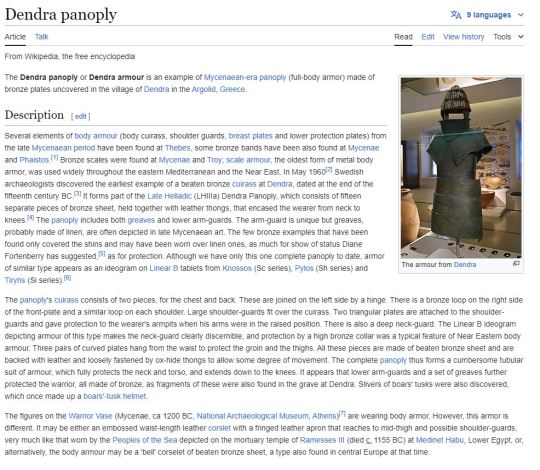


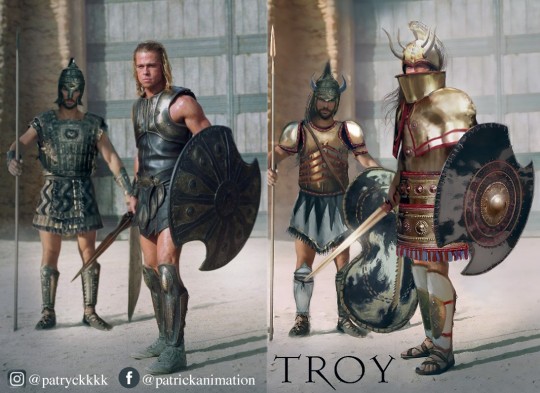
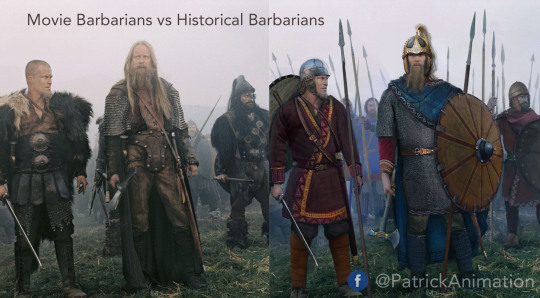

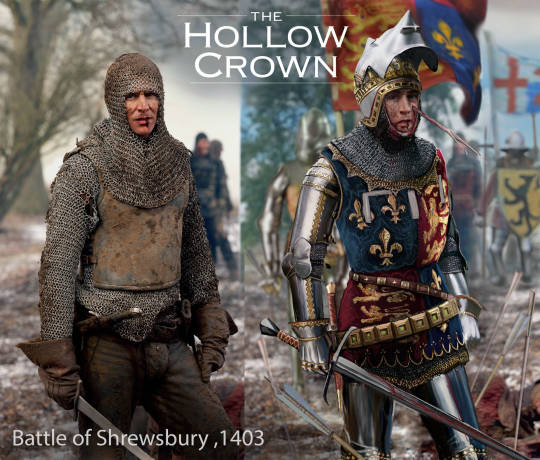

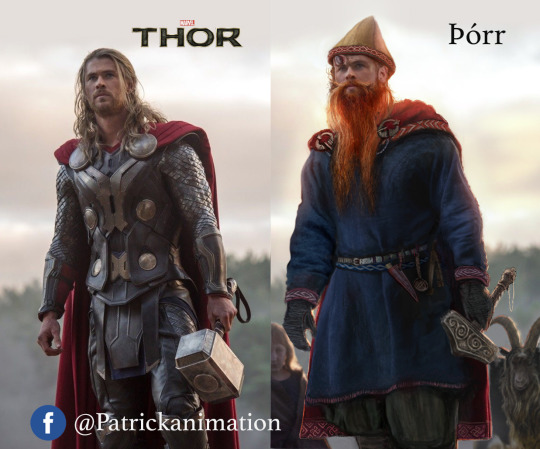
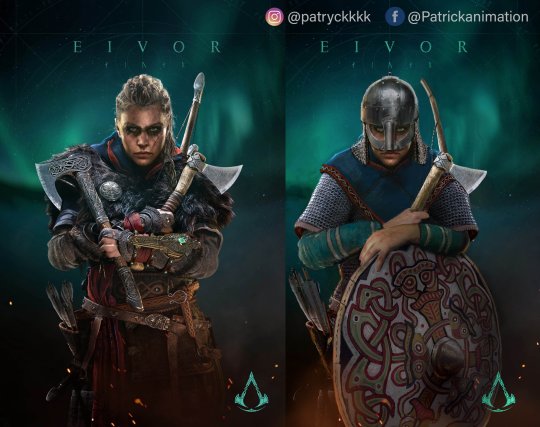
4K notes
·
View notes
Photo

The Dendra panoply or Dendra armour is an example of Mycenaean-era panoply (full-body armor) made of bronze plates uncovered in the village of Dendra in the Argolid, Greece. Learn more / Daha fazlası Dendra: https://www.archaeologs.com/w/dendra/
#archaeologs#archaeology#archaeological#dictionary#history#helladic#dendra#mycenaean#bronze age#argolid#greece#armor#arkeoloji#tarih#sanat#helladik#miken
112 notes
·
View notes
Text
I’d really love to see more actual (if interpreted) Mycenaean fashion in Greek myth art, since that’s the era the myths take place in!
I mean...


You can do this for the women! (Basically the exact same as fancy Minoan clothing.) Or, if you’re feeling lazy;

These charioteers give us other options, with the women on the right wearing similar, more simple style to the men on the left (just, undoubtedly, longer). You can be pretty saucy too, when it comes to the men...

tiny, short loincloths/kilts of some sort! And while we can’t really have Hoplite armour (sorry, no one in the Trojan war is wearing aesthetic hoplite armour, the Dendra panoply is yelling through the ages and their shields are very, very huge and shaped like squares and figure eights, BUT

For once, you can totally do horned helmets and be historically accurate!
#greek mythology#trojan war#please ;(#I know everyone likes the drapery aesthetics#BUT THIS IS COOL OKAY!!
25 notes
·
View notes
Text




Mycenaean Dendra armor 15th C. BCE
"Several elements of body armour (body cuirass, shoulder guards, breast plates and lower protection plates) from the late Mycenaean period have been found at Thebes, some bronze bands have been also found at Mycenae and Phaistos. Bronze scales were found at Mycenae and Troy; scale armour, the oldest form of metal body armor, was used widely throughout the eastern Mediterranean and the Near East. In May 1960 Swedish archaeologists discovered the earliest example of a beaten bronze cuirass at Dendra, dated to the end of the fifteenth century BC. It forms part of the Late Helladic (LHIIIa) Dendra Panoply, which consists of fifteen separate pieces of bronze sheet, held together with leather thongs, that encased the wearer from neck to knees. The panoply includes both greaves and lower arm-guards. The arm-guard is unique but greaves, probably made of linen, are often depicted in late Mycenaean art. The few bronze examples that have been found only covered the shins and may have been worn over linen ones, as much for show of status Diane Fortenberry has suggested, as for protection. Although we have only this one complete panoply to date, armor of similar type appears as an ideogram on Linear B tablets from Knossos (Sc series), Pylos (Sh series) and Tiryns (Si series). The panoply’s cuirass consists of two pieces, for the chest and back. These are joined on the left side by a hinge. There is a bronze loop on the right side of the front-plate and a similar loop on each shoulder. Large shoulder-guards fit over the cuirass. Two triangular plates are attached to the shoulder-guards and gave protection to the wearer’s armpits when his arms were in the raised position. There is also a deep neck-guard. The Linear B ideogram depicting armour of this type makes the neck-guard clearly discernible, and protection by a high bronze collar was a typical feature of Near Eastern body armour. Three pairs of curved plates hang from the waist to protect the groin and the thighs. All these pieces are made of beaten bronze sheet and are backed with leather and loosely fastened by ox-hide thongs to allow some degree of movement. The complete panoply thus forms a cumbersome tubular suit of armour, which fully protects the neck and torso, and extends down to the knees. It appears that lower arm-guards and a set of greaves further protected the warrior, all made of bronze, as fragments of these were also found in the grave at Dendra. Slivers of boars’ tusks were also discovered, which once made up a boars’-tusk helmet."
-taken from wikipedia
https://paganimagevault.blogspot.com/2020/02/mycenaean-dendra-armor-15th-c-bce.html
#mycenaean#ancient greece#greek#europe#pagan#paganism#european history#art history#ancient history#artifact#mycenae#15th century bce
12 notes
·
View notes
Note
And there's different sort of armour! The Dendra panoply is famous, so it's easy to get stuck on that that's all you have to work with (and it does look goofy, lol), but there were more than that.
A couple examples:



Possibly the chest armour on the Warrior krater here was only linen, but we can't know that for sure.
As always, I can't recommend this site enough: http://www.salimbeti.com/micenei/index.htm they have SO many pictures and it's all organised really easily. (For Iliad-era, you'll usually want everything under "late", but I have to admit I "cheat" sometimes and choose earlier artifacts just for, ahem, visual coolness' sake
How does one make mycenaean armor look so badass?
Omg Thank you. Glad you like it jjjj😭🫶🫶
Well I actually have some small tricks to do it, so please buckle up for a long answer.
1- It’s based on the stupidest revelation I have ever had, that armors are simply armors.
What I mean by this is that armors’ basic components are often unchanged overtime, even similar between cultures and lands.
Large pauldrons in Mycaenean armors functions albeit similar to medieval knights’ ones, the overall rigid structure of the dendra armor somehow reminds me of an early and western version of a samurai armor.
The curtains that protect the thighs (see my Diomedes’ armor design) have similar ones featured later in the Golden horde, Japanese and Chinese cultures.
In short treat it like any similarly cool armor in the world :))))
2 - I make small changes that might affect the overall looks and aesthetics, e.g dendra armor for Achilles is a bit more tight fit than its historical counterparts.
And frame the helmet lower towards the eye brows, to give it a more intimating look. (See doodle below ⬇️ )
3 - If the wearer’s badass, everything else is. Frame them in the coolest way possible, the rest will work for you. Found the second photo from Pinterest, the artist is Phoebe Herring.


27 notes
·
View notes
Text
Me, jolting up in bed: The Trojan War, according to Eratosthenes, took place in 1194-1184 BC, Achilles had and rode a chariot, the Dendra Panoply, largely considered a charioteer's armour, was in circulation from roughly 1650-1100 BC, this means it's feasible that Achilles would be wearing it and therefore I propose at the very least, a Hades au where Achilles wears this:

#'Finally an excuse to talk about my favourite armour' I say waking up from a nap with no idea what time it is or who I am#still very much sleep deprived but trying to get some rest before work#Pun's text Posts#Hades#Achilles#.... As confident as this reads I don't know my greek history that well so I may be wrong
26 notes
·
View notes
Text
As far as armor design/technology goes, Europe has been at the top of it thorough most of history. Starting with the Dendra panoply of the Mycenaean era and the heavy bronze armour of the latter Hellenic hoplites being the first examples in history that I'm aware of where large solid plates encased the torso (and sometimes limbs), rather than some kind of metal mesh, as well as large helmets with wide protrusions that covered most of the face. Roman era armour was also very sophisticated as well, both the various forms of body armor as well as the functionally intricate helmet designs, and of course we can't forget the fact that by all accounts and archeological evidence, mail armour seems to have originated in Europe, an invention attributed to the Celts by the Romans, although the oldest example found so far was in the Carpathian Basin. After the fall of the western Roman empire there were a several centuries were European armor stagnated and fell behind compared to what was used in most of the rest of the world, but by the 12-13th centuries it had caught up again, and by the 14th, with the advent of true full plate armour, Europe had surpassed the rest of the world again in its armour technology and would continue to do so all the way to the modern era. Metallurgy on the other hand is a different thing though. I'm nowhere near as well versed in this subject, but from what I've read it seems that European metallurgy was, up until the late renaissance, fairly mediocre compared to that of the rest of the world. The "global leader" in this regard, at least as far as I can tell, was India for pretty much all of history up until the industrial revolution, with crucible smelting allowing for the production of the high quality, homogeneous steel with little to no inclusions known as "wootz". This kind of steel was exported thorough most of the world, and was were the famed Damascus steel got its reputation, with Indian steel being imported to Damascus and then exported to Europe. Similarly, the famed Ulfbert swords (the genuine ones) were made out of imported wootz steel as well. In addition, war bows made entirely out of steel were known to have been used in India, something that would require very high metal quality to not just have the bow's limbs snap on deformation. Although these would have been inferior in power to wooden or composite bows, they would have been unaffected by the humidity of the region and could have been stored, fully strung, for extended periods of time in armouries with little maintenance.
#txt#armor#armour#medieval#I must admit though the metallurgy segment is limited in scope and could very well be outdated#apparently crucible smelting was also known in Sri Lanka and might have originated there#but that is right next to India so putting it as a separate when I'm already condensing the entirety of European and Indian kingdoms#and cultures into two categories seems unnecessary#regardless though apologies to any Sri Lankans reading this
2 notes
·
View notes
Photo




Reconstruction of early Mycaenean armour and weapons, from the Association of Historical Studies KORYVANTES.
Plate armour is an exact copy of Dendra armour presented in Nafplion Archeological Museum, and helmet is based on depiction from Medinet Habu, Mortuary Temple of Ramesses III, Luxor.
1 note
·
View note
Text
Great question @theeclectickoalastudent !
The Dendra armour that this is based on does indeed have a boars-tusk helmet:
However, the actual armour Agamemnon has described as having in the Iliad looks entirely different:

Details: https://helens-daughter.livejournal.com/91670.html
- and I drew a more accurate illustration of Agamemnon in my Trojan War Playset figures:

And Agamemnon’s helmet is described as “four plumes (or tufts) and two crests (or tubes) and the horsehair atop it tossing, bristling terror.” (Iliad XI 41-42)

So, not necessarily boars tusk. More here: http://www.salimbeti.com/micenei/helmets4.htm

So many gloriously weird Mycenaean helmets!
On the whole, I just decided to put Agamemnon in the most ostentatious, protective-looking armour possible, because, in the Iliad, he’s a great big chicken.
🥁
To explain my chicken obsession:
* * *
Me: I’m enjoying drawing chickens for this commission.
Husband: ha ha Greek Myth Chickens!
Me: 🤔
I now present to you,
🏺Greek Myth Chickens 🐓
ILIAD EDITION
1) Egg-chilles and Patro-cluck (Achilles and Patroclus)
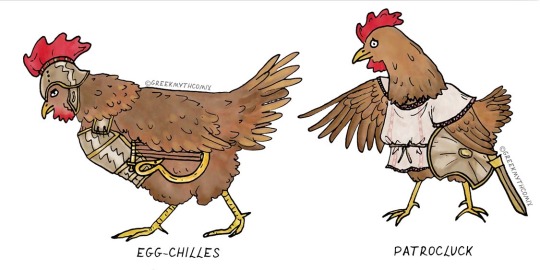
2) Mene-lay-us and Al-eggs-andros (Paris) (Menelaus and Alexandros [Paris])
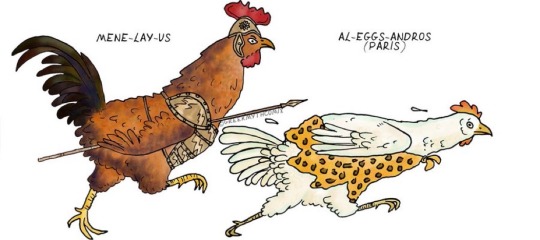
3) Egg-amemnon (Agamemnon)

4) Aph-roost-ite and Helen of Spur-ta (Aphrodite and Helen of Sparta)
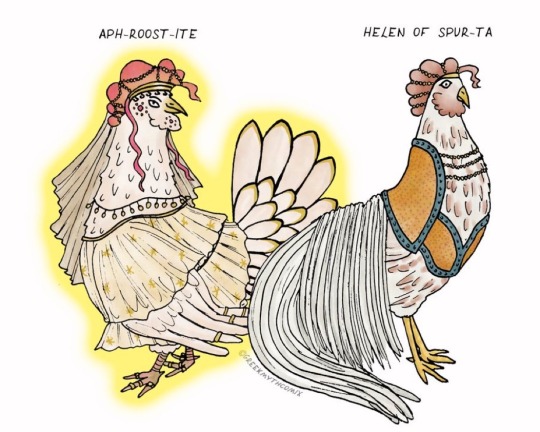
5) Nest-or (Nestor)
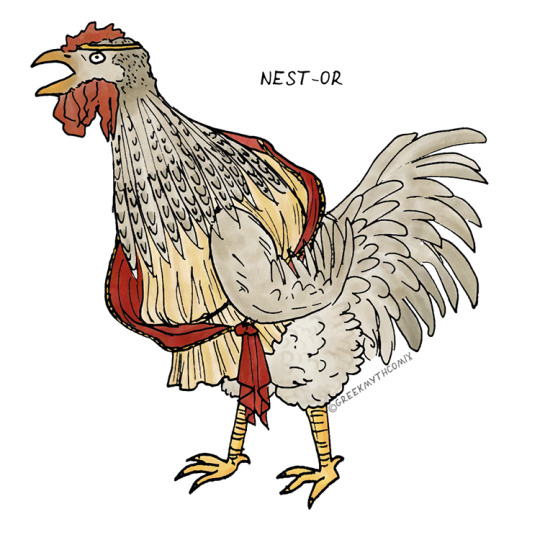
6) Androma-beak, Peck-tor, and Astyan-egg (Andromache, Hektor and Astyanax)
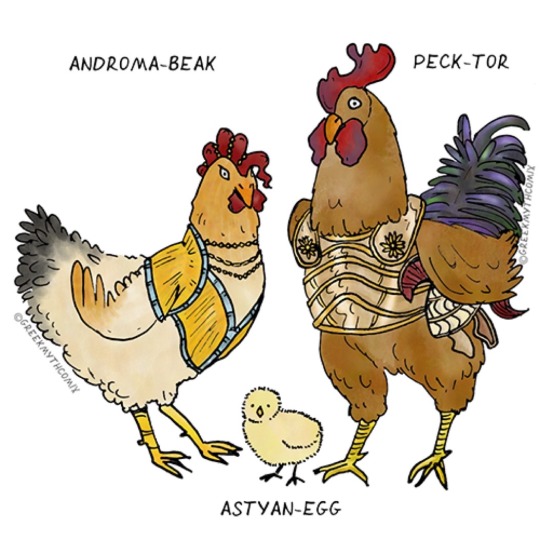
7) At-hen-a and Egg-dysseus (Athena and Odysseus)
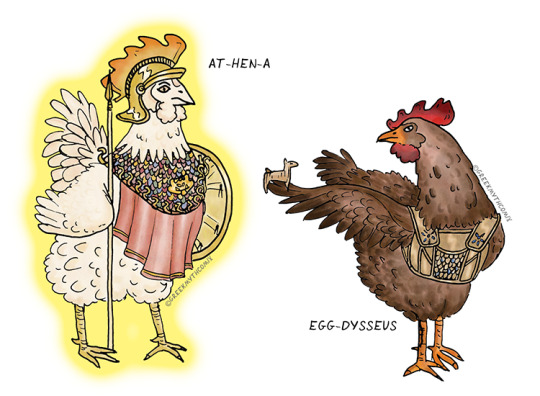
8) Preen-am and Peck-uba (Priam and Hekuba [Hekabe])

9) Brood-seis (Briseis)
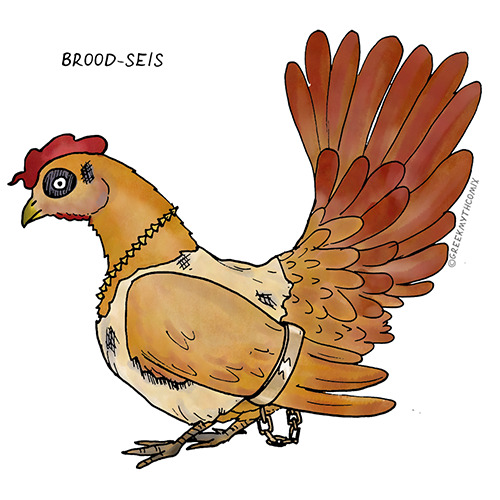
10) Diom-egg-es (Diomedes)
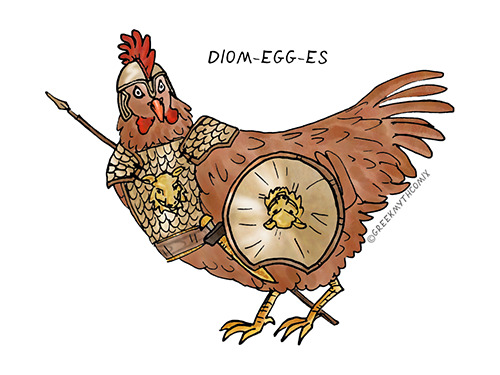
(See next post for last 3 - https://www.tumblr.com/greekmythcomix/722218945873051648/iliad-chickens-continued-11-lay-jax-tel-capon )
#mycenae#mycenaean#armour#reproduction#archaeological reconstruction#archaeological illustration#I did it for the giggles
12K notes
·
View notes
Photo




Greek Bronze and Gold Short Sword and Dagger, C. 1450-1300 BC
The daggers and early swords of the Aegean Bronze Age represent some of the most striking artifacts of the period in terms of their opulence, craftsmanship and display of technical virtuosity. Whilst some were used solely for ceremonial use, many were functional instruments of war, attested by the clear developments in form, according to fighting preferences and practices. The short sword, which developed from the dagger, is one of the most interesting innovations of the Bronze Age, often signifying social status in societies in which hierarchy and one-on-one combat were primary concerns. The present dagger and short sword probably originate from Crete, in the locality of the great palaces at Knossos, or from Mycenae. The Minoan and Mycenaean civilizations were renowned for their wealth, richness of culture, technical sophistication, and strong influence across the Greek world for centuries to come. These are the weapons of the fabled heroes of Troy, the great treasures of powerful kings like Agamemnon, who ruled over the kingdom of Mycenae.
Tombs containing daggers and short swords represent only a few of the total number known from the Late Bronze Age, suggesting that these thrusting weapons were owned by the richest, highest-ranking members of society. It is difficult to distinguish with certainty what is classified as a ‘short sword’ or ‘dagger’, but it is generally agreed that anything under 45 cm in length constitutes a dagger. The evolutionary process of these weapons has been classified by Sandars, who has catalogued the various types into eight main groups identified by the letters A to H.
This short sword belongs to the group Di, also known as ‘cross swords’ due to the configuration of the handle and cross-guard. They are characterised by their rounded lobe shoulder, thin blade with a well-raised rounded central rib, and flanged shoulders and tang. As here, they usually have two rivets in the shoulders and one (or three) in the tang. These swords are attested in Crete, on the Greek mainland, and on some Aegean islands such as Kos and Rhodes, and it is thought that their centre of production was at Knossos. On average, they measure about 60 cm. The type was invented and in use at the same time as its predecessor, the Ci type, and the two share many qualities. Both feature an elongated tang, which would have helped to remedy the weakness of the handle found in earlier sword types, and both were suitable for thrusting and cutting. The Di type, however, was created for a ‘hammer’ grip, which presents the edge of the blade forward, designed for a cutting action. The Ci type, by contrast, used a ‘sabre’ grip, allowing the forefinger to wrap around the lobed guard, creating a fighting action more reminiscent of fencing. That these two sword types were in use contemporaneously suggests the existence and encouragement of multifaceted specialized skills in warfare. They also attest to an independent, one-on-one style of combat, that was suited to the elitist, hierarchical nature of Minoan and Mycenaean society during this period. A particularly ornate type Ci sword was found in tomb 46 in Kydonia, Crete, measuring 83 cm long. Like ours, it features the gold rivets and rind on the grip, but also retains an ivory pommel, giving some indication of what our sword may originally have looked like. Type D swords have also been found at the palace of Knossos, Crete, also with gold rivets, and from Mycenae, with gold coverings on the handles (circa 1350 BC).
The smaller of these two weapons would likely have been used as a dagger, but it may also have functioned as a general-purpose cutting implement. In the shaft graves of Mycenae, several examples of these weapons have been found, for example a single cutting edge knife 33 cm in length in the tomb of the warrior Dendra (circa 1450-1400 BC). Its inclusion as a grave offering indicates that it was considered among the significant effects within the paraphernalia of a distinguished warrior. Just as the present example, four rivets are inserted into its tang, to hold in place a wooden covering. Similar knives are also attested in several Achaean settlements, for example a 27 cm long example from tomb number 529:25 in Mycenae (circa 1400 BC); and a narrow-bladed bronze dagger from Kydonia (1300 BC), as well as one from Sanatorium, Crete (1350-1300 BC).
The celebrated ostentation of hilt décor, such as on these examples, does not undermine the utility of these weapons – rather, it indicates the great prominence of their original owners. This sword and dagger both impressively retain their original gold rivets. These glittering spheres had both a decorative and practical function, since they held in place the ornate hand-grip which would have been made of wood or ivory, and perhaps was once overlaid in gold. The hand-grip was sometimes also topped by a knob made of ivory, amber or gold. The preservation of these rivets allows us to imagine something of the prestige these weapons once wielded. Indeed, Homer refers to swords with both gold and silver rivets in the Iliad, the most frequent epithets of the sword being arguroelon – ‘silver-studded’. In Book XI, we are told how Agamemnon assumes his armour: ‘But the son of Atreus shouted aloud and bade the Argives array them for battle, and himself amid them put on the gleaming bronze…about his shoulders he flung his sword, whereon gleamed studs of gold’. The significance of the present sword and dagger, then, lies in the way they combine aesthetic beauty with function and status, and in the way they offer a glimpse into the innovations of contemporary warfare. Above all, their attraction inheres in the fact that they represent the agents of war of the revered heroes of the epic cycle, who, through the flourish of such a sword, lived, were slain, and achieved eternal glory.
#history#greek#sword#dagger#bronze#gold#antiquities#ancient#weapons#15th century bc#14th century bc#13th century bc
660 notes
·
View notes
Photo

#inktober2018 day 21: despite the bizarre appearance of this armour, it's not a character from Lord of The Rings but a noble or elite warrior of ancient Mycenae, circa 1200BC. The armour is known as 'dendra' panoply or full body armour, and was made of overlapping bronze plates. Another one sketched in bad light with a cat refusing to move off my lap, so go easy 😉 #inktober2018 #ink #sketch #warrior #drawing #art #ancientgreece #mycenae #ancientworld #bronzeage #illustration #mattsoffe https://www.instagram.com/p/BpNekkiH8EP/?utm_source=ig_tumblr_share&igshid=15nn48rw8kvjw
#inktober2018#ink#sketch#warrior#drawing#art#ancientgreece#mycenae#ancientworld#bronzeage#illustration#mattsoffe
0 notes